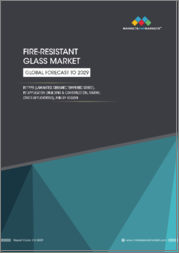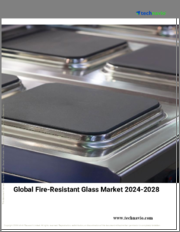
|
시장보고서
상품코드
1801115
내화 유리 시장 보고서 : 유형, 용도, 지역별(2025-2033년)Fire Resistant Glass Market Report by Type (Wired, Ceramic, Laminated, Tempered, Gel Filled), Application (Building and Construction, Marine, and Others), and Region 2025-2033 |
||||||
세계 내화 유리 시장 규모는 2024년 57억 달러에 달했습니다. IMARC Group은 2025-2033년 연평균 성장률(CAGR) 8.71%로 2033년에는 124억 달러에 달할 것으로 예측했습니다.
내화 유리는 화재, 연기, 열전도에 대한 보호 기능을 제공하는 특수 유리입니다. 단층 또는 복층으로 주로 접합유리, 망입유리, 강화유리, 세라믹유리, 겔형 내화 유리로 나뉩니다. 이 유리는 밀실 공포와 같은 공간을 만들지 않고 제한된 지역으로의 연소를 제한합니다. 또한, 내열성, 비산방지, 높은 충격 안전성, 방음성, 다양한 디자인성 등 다른 장점도 있습니다. 그 결과, 내화 유리는 건축, 해양, 운송, 국방 분야에서 기존 유리를 대체할 수 있는 안전한 대안으로 널리 채택되고 있습니다.
내화 유리 시장 동향
도시화의 진전과 현대적 인프라 사업에 대한 수요 증가가 내화 유리 시장의 성장을 주도하고 있습니다. 또한, 주거, 상업, 산업 각 부문에서 화재 발생 건수가 증가함에 따라 인명피해가 증가하고 있어 내화 유리의 필요성이 높아지고 있습니다. 또한, 리모델링 및 리노베이션 시 기존 유리에서 내화 유리로 전환이 진행되고 있는 것도 시장 성장을 견인하고 있습니다. 이 외에도 내화 유리는 강화된 내충격, 방음, 내열 성능을 바탕으로 해양 산업에서 널리 사용되고 있습니다. 또한, 자동차 산업의 확대는 앞유리, 창유리, 인테리어 유리 제조에 있어 내화 유리의 수요를 촉진하고 있습니다. 이 외에도 방위 산업에서 장갑차, 보병전투차, 모니터링 장비에 내화 유리 채택이 확대되면서 시장 성장을 견인하고 있습니다. 또한, 일부 정부 기관은 화재 예방을 보장하기 위해 주거 및 상업용 건물에 내화 유리를 채택하는 것에 대한 여러 가지 안전 기준을 도입했습니다.
본 보고서에서 다루는 주요 질문
- 세계 내화 유리 시장은 지금까지 어떻게 성장해 왔으며, 향후 몇 년 동안 어떻게 성장할 것인가?
- 주요 지역 시장은?
- COVID-19가 내화 유리 세계 시장에 미치는 영향은?
- 유형별 시장 분석은?
- 용도에 따른 시장 분석은?
- 산업 가치사슬의 다양한 단계는 무엇인가?
- 시장의 주요 촉진요인과 과제는 무엇인가?
- 세계 내화 유리 시장 구조와 주요 진출 기업은?
- 시장에서의 경쟁은 어느 정도인가?
목차
제1장 서문
제2장 조사 범위와 조사 방법
- 조사 목적
- 이해관계자
- 데이터 소스
- 1차 정보
- 2차 정보
- 시장 추정
- 상향식 접근
- 하향식 접근
- 조사 방법
제3장 주요 요약
제4장 소개
제5장 세계의 내화 유리 시장
- 시장 개요
- 시장 실적
- COVID-19의 영향
- 시장 예측
제6장 시장 내역 : 유형별
- 유선
- 세라믹
- 시장 동향
- 라미네이트 가공
- 시장 동향
- 강화
- 시장 동향
- 겔 충전
- 시장 동향
제7장 시장 내역 : 용도별
- 건축·건설
- 주요 유형
- 주택 건설
- 상업 건설
- 주요 유형
- 해양
- 기타
제8장 시장 내역 : 지역별
- 북미
- 미국
- 캐나다
- 아시아태평양
- 중국
- 일본
- 인도
- 한국
- 호주
- 인도네시아
- 기타
- 유럽
- 독일
- 프랑스
- 영국
- 이탈리아
- 스페인
- 러시아
- 기타
- 라틴아메리카
- 브라질
- 멕시코
- 기타
- 중동 및 아프리카
제9장 SWOT 분석
제10장 밸류체인 분석
제11장 Porter's Five Forces 분석
제12장 경쟁 구도
- 시장 구조
- 주요 기업
- 주요 기업 개요
- AGC Inc.
- Compagnie De Saint Gobain S.A.
- Fuso Glass India Pvt Ltd.
- Nippon Sheet Glass Co. Ltd.
- Pyroguard Engineers Pvt. Ltd.
- Promat International Nv(Etex Group)
- Ravensby Glass Co. Ltd.(Malcolm, Ogilvie & Co. Ltd. Group)
- Schott AG(Carl-Zeiss-Stiftung)
- Safti First Fire Rated Glazing Solutions(O'Keeffe's Inc.)
- Technical Glass Products Inc.(Allegion Plc)
The global fire resistant glass market size reached USD 5.7 Billion in 2024. Looking forward, IMARC Group expects the market to reach USD 12.4 Billion by 2033, exhibiting a growth rate (CAGR) of 8.71% during 2025-2033.
Fire resistant or fire-rated glass refers to a specialty glass variant that provides protection against fire, smoke, and conductive heat transfer. It is either single- or multi-layered and is primarily classified as laminated, wired, tempered, ceramic and gel based fire-resistant glass. The glass restricts the spread of fire to a limited area without creating a claustrophobic atmosphere. It also offers several additional benefits, such as thermal resistance, shatter resistance, high impact safety, sound reduction, wide design potential, etc. As a result, fire-resistant glass is widely adopted as a safer alternative to conventional glass across the construction, marine, transportation and defense sectors.
Fire Resistant Glass Market Trends:
The growing levels of urbanization coupled with increasing demand for modern infrastructure projects are primarily driving the growth of the fire-resistant glass market. Furthermore, the rising incidences of fire breakouts across the residential, commercial, and industrial sectors have led to the escalating number of casualties, thereby augmenting the need for fire-resistant glass. Additionally, the growing shift from conventional glass towards fire-resistant glass for several remodeling and renovation activities is also augmenting the market growth. Apart from this, fire-resistant glass is widely utilized in the marine industry based on its enhanced impact, acoustic, and thermal performance. Moreover, the expanding automobile sector is also driving the demand for fire-resistant glass for manufacturing windscreens, windows, and interior glasses. Besides this, the growing adoption of fire-resistant glass in the defense industry for armored personal carriers, infantry fighting vehicles, and surveillance equipment, is also propelling the market growth. Furthermore, several government bodies have also introduced multiple safety standards pertaining to the adoption of fire-resistant glass in the residential and commercial buildings to ensure fire prevention.
Key Market Segmentation:
Breakup by Type:
- Wired
- Ceramic
- Laminated
- Tempered
- Gel Filled
Breakup by Application:
- Building and Construction
- Residential Construction
- Commercial Construction
- Marine
- Others
Breakup by Region:
- North America
- United States
- Canada
- Asia Pacific
- China
- Japan
- India
- South Korea
- Australia
- Indonesia
- Others
- Europe
- Germany
- France
- United Kingdom
- Italy
- Spain
- Russia
- Others
- Latin America
- Brazil
- Mexico
- Others
- Middle East and Africa
Competitive Landscape:
The competitive landscape of the industry has also been examined with some of the key players being AGC Inc., Compagnie De Saint Gobain S.A., Fuso Glass India Pvt Ltd., Nippon Sheet Glass Co. Ltd., Pyroguard Engineers Pvt. Ltd., Promat International NV (Etex Group), Ravensby Glass Co. Ltd. (Malcolm, Ogilvie & Co. Ltd. Group), Schott AG (Carl-Zeiss-Stiftung), Safti First Fire Rated Glazing Solutions (O'Keeffe's Inc.) and Technical Glass Products Inc. (Allegion Plc).
Key Questions Answered in This Report:
- How has the global fire resistant glass market performed so far and how will it perform in the coming years?
- What are the key regional markets?
- What is the impact of COVID-19 on global fire resistant glass market?
- What is the breakup of the market based on the type?
- What is the breakup of the market based on the application?
- What are the various stages in the value chain of the industry?
- What are the key driving factors and challenges in the market?
- What is the structure of the global fire resistant glass market and who are the key players?
- What is the degree of competition in the market?
Table of Contents
1 Preface
2 Scope and Methodology
- 2.1 Objectives of the Study
- 2.2 Stakeholders
- 2.3 Data Sources
- 2.3.1 Primary Sources
- 2.3.2 Secondary Sources
- 2.4 Market Estimation
- 2.4.1 Bottom-Up Approach
- 2.4.2 Top-Down Approach
- 2.5 Forecasting Methodology
3 Executive Summary
4 Introduction
- 4.1 Overview
- 4.2 Key Industry Trends
5 Global Fire Resistant Glass Market
- 5.1 Market Overview
- 5.2 Market Performance
- 5.3 Impact of COVID-19
- 5.4 Market Forecast
6 Market Breakup by Type
- 6.1 Wired
- 6.1.1 Market Trends
- 6.1.2 Market Forecast
- 6.2 Ceramic
- 6.2.1 Market Trend
- 6.2.2 Market Forecast
- 6.3 Laminated
- 6.3.1 Market Trend
- 6.3.2 Market Forecast
- 6.4 Tempered
- 6.4.1 Market Trend
- 6.4.2 Market Forecast
- 6.5 Gel Filled
- 6.5.1 Market Trend
- 6.5.2 Market Forecast
7 Market Breakup by Application
- 7.1 Building and Construction
- 7.1.1 Market Trends
- 7.1.2 Major Types
- 7.1.2.1 Residential Construction
- 7.1.2.2 Commercial Construction
- 7.1.3 Market Forecast
- 7.2 Marine
- 7.2.1 Market Trends
- 7.2.2 Market Forecast
- 7.3 Others
- 7.3.1 Market Trends
- 7.3.2 Market Forecast
8 Market Breakup by Region
- 8.1 North America
- 8.1.1 United States
- 8.1.1.1 Market Trends
- 8.1.1.2 Market Forecast
- 8.1.2 Canada
- 8.1.2.1 Market Trends
- 8.1.2.2 Market Forecast
- 8.1.1 United States
- 8.2 Asia Pacific
- 8.2.1 China
- 8.2.1.1 Market Trends
- 8.2.1.2 Market Forecast
- 8.2.2 Japan
- 8.2.2.1 Market Trends
- 8.2.2.2 Market Forecast
- 8.2.3 India
- 8.2.3.1 Market Trends
- 8.2.3.2 Market Forecast
- 8.2.4 South Korea
- 8.2.4.1 Market Trends
- 8.2.4.2 Market Forecast
- 8.2.5 Australia
- 8.2.5.1 Market Trends
- 8.2.5.2 Market Forecast
- 8.2.6 Indonesia
- 8.2.6.1 Market Trends
- 8.2.6.2 Market Forecast
- 8.2.7 Others
- 8.2.7.1 Market Trends
- 8.2.7.2 Market Forecast
- 8.2.1 China
- 8.3 Europe
- 8.3.1 Germany
- 8.3.1.1 Market Trends
- 8.3.1.2 Market Forecast
- 8.3.2 France
- 8.3.2.1 Market Trends
- 8.3.2.2 Market Forecast
- 8.3.3 United Kingdom
- 8.3.3.1 Market Trends
- 8.3.3.2 Market Forecast
- 8.3.4 Italy
- 8.3.4.1 Market Trends
- 8.3.4.2 Market Forecast
- 8.3.5 Spain
- 8.3.5.1 Market Trends
- 8.3.5.2 Market Forecast
- 8.3.6 Russia
- 8.3.6.1 Market Trends
- 8.3.6.2 Market Forecast
- 8.3.7 Others
- 8.3.7.1 Market Trends
- 8.3.7.2 Market Forecast
- 8.3.1 Germany
- 8.4 Latin America
- 8.4.1 Brazil
- 8.4.1.1 Market Trends
- 8.4.1.2 Market Forecast
- 8.4.2 Mexico
- 8.4.2.1 Market Trends
- 8.4.2.2 Market Forecast
- 8.4.3 Others
- 8.4.3.1 Market Trends
- 8.4.3.2 Market Forecast
- 8.4.1 Brazil
- 8.5 Middle East and Africa
- 8.5.1 Market Trends
- 8.5.2 Market Breakup by Country
- 8.5.3 Market Forecast
9 SWOT Analysis
- 9.1 Overview
- 9.2 Strengths
- 9.3 Weaknesses
- 9.4 Opportunities
- 9.5 Threats
10 Value Chain Analysis
11 Porters Five Forces Analysis
- 11.1 Overview
- 11.2 Bargaining Power of Buyers
- 11.3 Bargaining Power of Suppliers
- 11.4 Degree of Competition
- 11.5 Threat of New Entrants
- 11.6 Threat of Substitutes
12 Competitive Landscape
- 12.1 Market Structure
- 12.2 Key Players
- 12.3 Profiles of Key Players
- 12.3.1 AGC Inc.
- 12.3.1.1 Company Overview
- 12.3.1.2 Product Portfolio
- 12.3.1.3 Financial
- 12.3.1.4 SWOT Analysis
- 12.3.2 Compagnie De Saint Gobain S.A.
- 12.3.2.1 Company Overview
- 12.3.2.2 Product Portfolio
- 12.3.2.3 Financial
- 12.3.2.4 SWOT Analysis
- 12.3.3 Fuso Glass India Pvt Ltd.
- 12.3.3.1 Company Overview
- 12.3.3.2 Product Portfolio
- 12.3.4 Nippon Sheet Glass Co. Ltd.
- 12.3.4.1 Company Overview
- 12.3.4.2 Product Portfolio
- 12.3.4.3 Financials
- 12.3.4.4 SWOT Analysis
- 12.3.5 Pyroguard Engineers Pvt. Ltd.
- 12.3.5.1 Company Overview
- 12.3.5.2 Product Portfolio
- 12.3.6 Promat International Nv (Etex Group)
- 12.3.6.1 Company Overview
- 12.3.6.2 Product Portfolio
- 12.3.7 Ravensby Glass Co. Ltd. (Malcolm, Ogilvie & Co. Ltd. Group)
- 12.3.7.1 Company Overview
- 12.3.7.2 Product Portfolio
- 12.3.8 Schott AG (Carl-Zeiss-Stiftung)
- 12.3.8.1 Company Overview
- 12.3.8.2 Product Portfolio
- 12.3.8.3 SWOT Analysis
- 12.3.9 Safti First Fire Rated Glazing Solutions (O'Keeffe's Inc.)
- 12.3.9.1 Company Overview
- 12.3.9.2 Product Portfolio
- 12.3.10 Technical Glass Products Inc. (Allegion Plc)
- 12.3.10.1 Company Overview
- 12.3.10.2 Product Portfolio
- 12.3.10.3 Financial
- 12.3.1 AGC Inc.



















